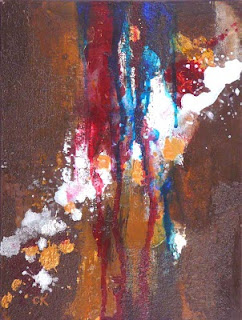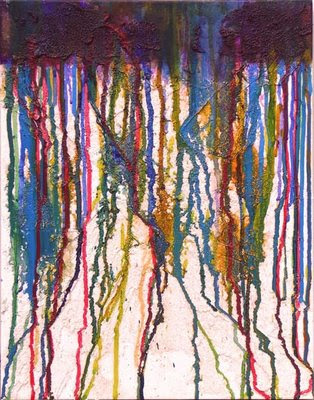 30 x 40 x 1.5", acrylic and mixed media on stretched canvas
30 x 40 x 1.5", acrylic and mixed media on stretched canvas
12/2012 update: I first took this to a textured abstract class and mucked with it, then painted over it. It now looks like
this.
It's been a busy time, getting myself settled in at
Gallery 2611. I have some studio space there, yay!, but I needed to set that up. That meant a trip to Ikea, and two -- two! -- repeat trips to get missing parts. I also treated myself to a gorgeous new easel, and bought more paints, brushes, and texturing supplies. So I haven't made much time to paint.
However, I did this piece last month or so. I almost named it The Fighter, but the current title feels right (and almost sounds the same). But the reason I almost named it The Fighter is because it was one of those paintings that just had a mind of its own, and wasn't going to cooperate with any plans or concepts I had. I cajoled it, changed compositions, let it sit, revisited it, and, finally, here it is. I think maybe the struggle shows a bit, and I like that.
For those of you interested in art process, here's how I got to the final image:
Step 1: I wanted to play with my drippies (I really need a better name for those...), but on the diagonal instead of up and down. I played with a few compositions in Photoshop, along with a few palettes, and came up with this as my concept:

Background goes from dark to light, and the stripes are in a middle value, so they kind of merge with the background in the middle. I also looked at it the other way around:

That's a funny thing about abstracts: They are not glued to an orientation. I mean, seriously. Those of you who do landscapes or figure painting, do you ever rotate your work to see if it would look better oriented that way? Isn't that a bizarre concept? Well, kind of. Ultimately a work flies or falls based on the composition and we do often look at art from a different perspective to see what we can learn.
Step 2: I had a couple of nails on the wall, and I hung the painting so the drippies would go at an angle. I put another canvas underneath just to see what would happen with the drops that fell off this one. Here's the first version.

Frankly, meh! Not so good. The Photoshop version made promises I was unable to keep. (And if I'm wrong and you like it, tell me!) I think I thrashed for awhile at this point, and eventually decided I had to have a new concept.
Step 3: Now, one of my theories in making textured art is that no underpainting is wasted; it is merely source material and adds richness to whatever you put on it. Personally, I like success by definition. So, after "meh," a small explosion occurred and this emerged:

Kind of ghostly, kind of interesting, but, aughh! it still wasn't there. (Again, feel free to totally disagree with me. I'd like to think everything I touch is brilliant.) (Yeah, right. Maybe if I was Picasso.) You can see where the drip lines cross near the middle, though.
Step 4? Sadly, I didn't document the transition from the penultimate to the ultimate painting. But, like an
earlier painting, I'm surprised at the iterations and how different they were. (And now, glad to have this record of it.)
End note: And interesting resource. I found a wonderful blog whose author talks straight to artists. It's Edward Winkleman's blog. He works out of Chelsea, New York, and gives wonderful, honest information, much of it useful to emerging artists. Here's a link to his excellent page on
finding a gallery.
 On the Vine, 6x8", oil on canvas board
On the Vine, 6x8", oil on canvas board But it didn't seem right. It was too swirly, because of the shape of the tomatoes. Now, in my color experiments, I seem to keep the original color of the objects in the well-lit portions, and add the creative colors in the shadows. And that seemed a bit bogus, so this one sat on my shelf. Then, a few days ago at the grocery store, I saw another set of yellow tomatoes on the vine. I bought them and used them as a basis to clean this one up. I'm now happier with it. Interestingly, I kind of like the shadows on the table top. I enjoy the effect of cutting in, and I did that with successively lighter colored paint. If I vary the paint color in any area rather than keeping it smooth and matte, it makes it look richer.
But it didn't seem right. It was too swirly, because of the shape of the tomatoes. Now, in my color experiments, I seem to keep the original color of the objects in the well-lit portions, and add the creative colors in the shadows. And that seemed a bit bogus, so this one sat on my shelf. Then, a few days ago at the grocery store, I saw another set of yellow tomatoes on the vine. I bought them and used them as a basis to clean this one up. I'm now happier with it. Interestingly, I kind of like the shadows on the table top. I enjoy the effect of cutting in, and I did that with successively lighter colored paint. If I vary the paint color in any area rather than keeping it smooth and matte, it makes it look richer. I'm working on doing a 6x6 a day for five days. I'd love to be able to do the daily thing, but it seems like I can't. But five days seems doable. They'll be appearing in the next week or so.
I'm working on doing a 6x6 a day for five days. I'd love to be able to do the daily thing, but it seems like I can't. But five days seems doable. They'll be appearing in the next week or so.













































